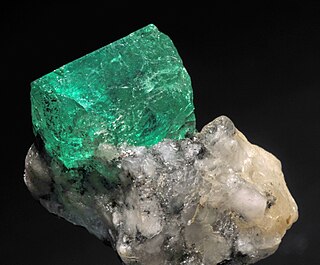
Emerald is a gemstone and a variety of the mineral beryl (Be3Al2(SiO3)6) colored green by trace amounts of chromium or sometimes vanadium. Beryl has a hardness of 7.5–8 on the Mohs scale. Most emeralds are highly included, so their toughness (resistance to breakage) is classified as generally poor. Emerald is a cyclosilicate.

Jewellery or jewelry consists of decorative items worn for personal adornment, such as brooches, rings, necklaces, earrings, pendants, bracelets, and cufflinks. Jewellery may be attached to the body or the clothes. From a western perspective, the term is restricted to durable ornaments, excluding flowers for example. For many centuries metal such as gold often combined with gemstones, has been the normal material for jewellery, but other materials such as shells and other plant materials may be used.

The Hope Diamond is a 45.52-carat (9.104 g) diamond originally extracted in the 17th century from the Kollur Mine in Guntur, India. It is blue in color due to trace amounts of boron. Its exceptional size has revealed new information about the formation of diamonds.
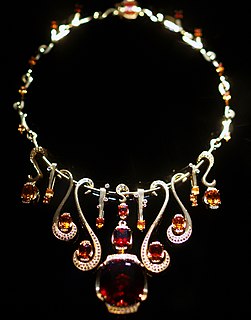
A necklace is an article of jewellery that is worn around the neck. Necklaces may have been one of the earliest types of adornment worn by humans. They often serve ceremonial, religious, magical, or funerary purposes and are also used as symbols of wealth and status, given that they are commonly made of precious metals and stones.

The French Crown Jewels comprise the crowns, orb, sceptres, diadems and jewels that were symbols of Royal power between 752 and 1825. These were worn by many Kings and Queens of France. The set was finally broken up, with most of it sold off in 1885 by the Third Republic. The surviving French Crown Jewels, principally a set of historic crowns, diadems and parures, are mainly on display in the Galerie d'Apollon of the Louvre, France's premier museum and former royal palace, together with the Regent Diamond, the Sancy Diamond and the 105-carat (21.0 g) Côte-de-Bretagne red spinel, carved into the form of a dragon. In addition, some gemstones and jewels are on display in the Treasury vault of the Mineralogy gallery in the National Museum of Natural History.

The Iranian National Jewels, originally the Iranian Crown Jewels, include elaborate crowns, thirty tiaras, and numerous aigrettes, a dozen bejeweled swords and shields, a number of unset precious gems, numerous plates and other dining services cast in precious metals and encrusted with gems, and several other more unusual items collected or worn by the Persian monarchs from the 16th century and on. The collection is housed at the Treasury of National Jewels, situated inside the Central Bank of Iran on Tehran's Ferdowsi Avenue.
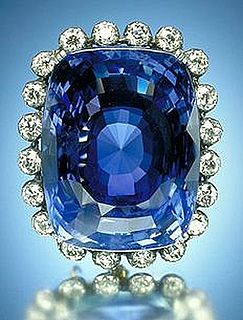
The Logan Sapphire is a flawless specimen from Sri Lanka, a cushion-cut stone which possesses a rich deep blue color and is the second largest (blue) sapphire known, weighing 422.99 carats.

Harry Winston was an American jeweler. He donated the Hope Diamond to the Smithsonian Institution in 1958 after owning it for a decade. He also traded the Portuguese Diamond to the Smithsonian in 1963 in exchange for 3,800 carats of small diamonds.

The Chalk Emerald is a 37.82 carats (7.564 g) Colombian emerald.
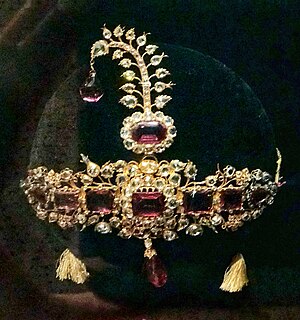
The Jewels of the Nizams of Hyderabad State are among the largest and most expensive collection of jewels in present-day India. The jewels belonged to the Nizams. After the annexation of their kingdom by Union of India, the Nizam and his heirs were barred by the Indian government from taking the collection, claiming that it was a national treasure. After much litigation, the diamond was purchased by the Government of India from the nizam's trust for an estimated $13 million in 1995, along with other jewels of the nizams, and is held at the Reserve Bank of India vaults in Mumbai.

The monarch of the Commonwealth realms, Queen Elizabeth II, owns a historic collection of jewels – some as monarch and others as a private individual. They are separate from the Gems and Jewels and the coronation and state regalia that make up the Crown Jewels.

The Napoleon Diamond Necklace is a diamond necklace commissioned by Napoleon I of France c. 1811–1812. It is currently on display in the Smithsonian Institution in Washington, D.C., United States.
Maharani Sita Devi Sahib of Baroda, born to Telugu family on 12 May 1917 in Madras, India, died 15 February 1989 in Paris, France. She was known as the "Indian Wallis Simpson". She was a colourful lady who led an extravagant life for over 40 years and was a member of the international jet set.

The Portuguese Diamond is a large octagonal-cut diamond known for its flawlessness and clarity. It weighs 127.01 carats (25.402 g).

The Hooker Emerald Brooch is an emerald brooch designed by Tiffany & Co. The brooch is on display in the Janet Annenberg Hooker Hall of Geology, Gems, and Minerals at the Smithsonian Institution's National Museum of Natural History in Washington D.C., United States.

The Hall Sapphire and Diamond Necklace has 36 matched sapphires from Sri Lanka which total 195 carats. These sapphires are surrounded by 435 brilliant-cut diamonds that total 83.75 carats. The sapphires are cushion-cut, some of the diamonds are pear-shaped and the others are round cut. The setting is platinum.
Cindy Chao is a Taiwanese jewellery designer. She founded her company, Cindy Chao The Art Jewel, in 2004. She is known for her Black Label Masterpiece Collection and Annual Butterfly.
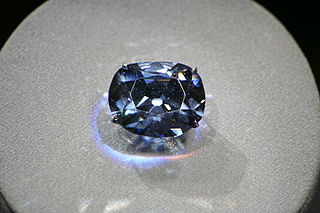
Blue diamond is a type of diamond which exhibits all of the same inherent properties of the mineral except with the additional element of blue color in the stone. They are colored blue by trace amounts of boron that contaminate the crystalline lattice structure. Blue diamonds belong to a subcategory of diamonds called fancy color diamonds, the generic name for diamonds that exhibit intense color.
















